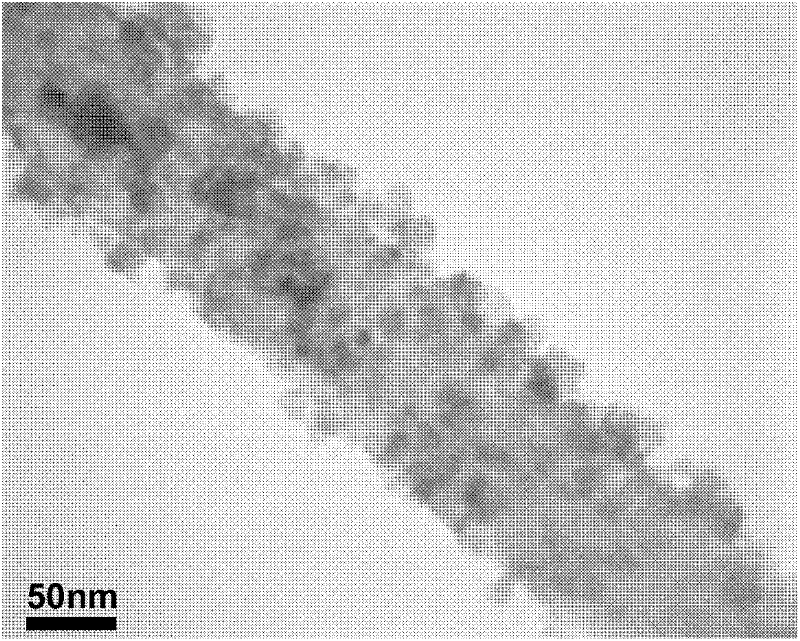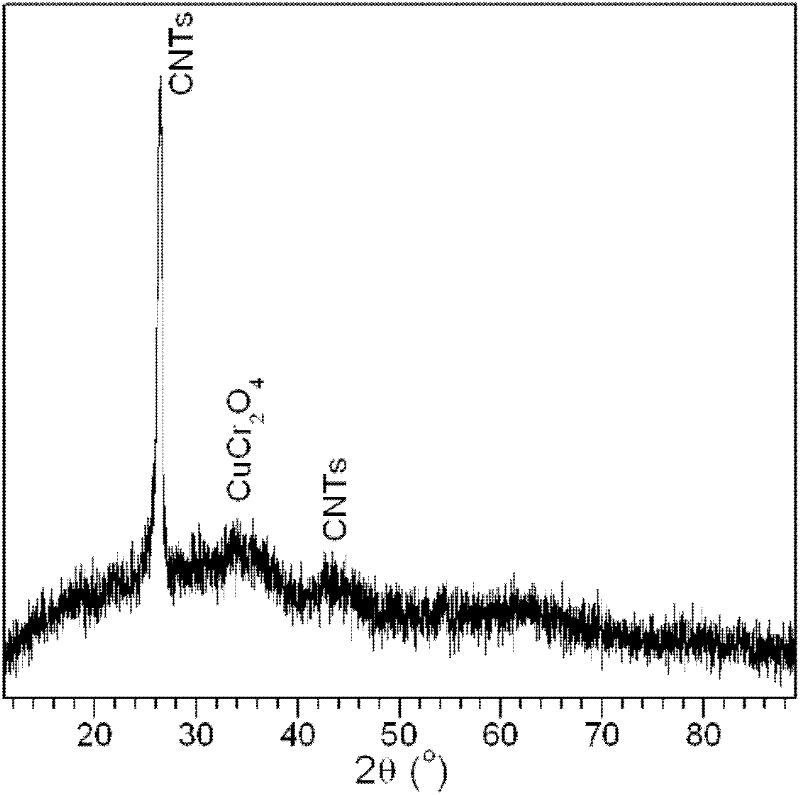Copper chromite/carbon nanotube nano-composite catalyst, preparation method and application
A technology of carbon nanotubes and copper chromite, which is applied in the field of preparation of copper chromite/carbon nanotube nanocomposite catalysts and its preparation, can solve the problems of reducing catalyst catalytic efficiency and easy agglomeration, and achieve excellent catalytic effects
- Summary
- Abstract
- Description
- Claims
- Application Information
AI Technical Summary
Problems solved by technology
Method used
Image
Examples
Embodiment 1
[0022] (1) Weigh 1 g of multi-walled carbon nanotubes into a round bottom flask, add concentrated nitric acid, ultrasonicate for 30 minutes, reflux at 90° C. for 3 hours, cool, filter, wash, and dry.
[0023] (2) Weigh 1.2765g of copper nitrate hexahydrate and 3.4564g of chromium nitrate nonahydrate into an in-situ flask, add deionized water and stir to dissolve. 1 g of multi-walled carbon nanotubes oxidized in step (1) was added, ultrasonicated for 30 minutes, stirred at 30° C. for 5 hours, and then left to stand for 12 hours. Concentrated aqueous ammonia was added dropwise under stirring at 30°C until the pH value was 8.5, and then stood still for 4 hours. Filter with suction, wash the product three times with distilled water and ethanol successively, and dry.
[0024] (3) Calcining at 280° C. for 2 hours under an air atmosphere, the copper chromite / carbon nanotube nanocomposite catalyst can be prepared. The transmission electron microscope photograph of gained copper chro...
Embodiment 2
[0026] (1) Weigh 1 g of multi-walled carbon nanotubes into a round bottom flask, add concentrated nitric acid, ultrasonicate for 30 minutes, reflux at 90° C. for 3 hours, cool, filter, wash, and dry.
[0027] (2) Take by weighing 1.9147g of copper nitrate hexahydrate and 5.1846g of chromium nitrate nonahydrate in a round bottom flask, add deionized water and stir to dissolve; then, add 1g of multi-walled carbon nanotubes through step (1) oxidation treatment , sonicated for 30 min, stirred at 30 °C for 5 h, and then allowed to stand for 12 h. Concentrated aqueous ammonia was added dropwise under stirring at 30°C until the pH value was 8.5, and then stood still for 4 hours. Filter with suction, wash the product three times with distilled water and ethanol successively, and dry.
[0028] (3) Calcining at 320° C. for 2 hours under an air atmosphere, the copper chromite / carbon nanotube nanocomposite catalyst can be prepared.
Embodiment 3
[0030] (1) Weigh 1 g of multi-walled carbon nanotubes into a round bottom flask, add concentrated nitric acid, ultrasonicate for 30 minutes, reflux at a temperature of 90° C. for 3 hours, cool, filter, wash, and dry.
[0031] (2) Weigh 0.3156g of copper chloride dihydrate and 1.4813g of chromium nitrate nonahydrate in a round bottom flask, add deionized water and stir to dissolve; then, add 1g of multi-walled carbon nanometer through step (1) oxidation treatment Tubes were sonicated for 30 min, stirred at 30 °C for 5 h, and then allowed to stand for 12 h. Concentrated aqueous ammonia was added dropwise under stirring at 30°C until the pH value was 8.5, and then stood still for 4 hours. Filter with suction, wash the product three times with distilled water and ethanol successively, and dry.
[0032] (3) Calcining at 320° C. for 2 hours under an air atmosphere, the copper chromite / carbon nanotube nanocomposite catalyst can be prepared.
PUM
| Property | Measurement | Unit |
|---|---|---|
| diameter | aaaaa | aaaaa |
Abstract
Description
Claims
Application Information
 Login to View More
Login to View More - R&D
- Intellectual Property
- Life Sciences
- Materials
- Tech Scout
- Unparalleled Data Quality
- Higher Quality Content
- 60% Fewer Hallucinations
Browse by: Latest US Patents, China's latest patents, Technical Efficacy Thesaurus, Application Domain, Technology Topic, Popular Technical Reports.
© 2025 PatSnap. All rights reserved.Legal|Privacy policy|Modern Slavery Act Transparency Statement|Sitemap|About US| Contact US: help@patsnap.com


